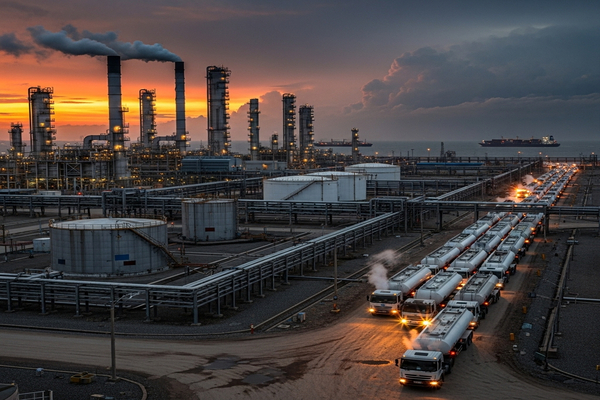
Russia sanctions turbocharge diesel market. New U.S. and British measures targeting Rosneft (MOEX:ROSN) and Lukoil (MOEX:LKOH) have sent diesel margins soaring and forced buyers to re-route flows. This matters now because the rules close previous loopholes and follow a fresh EU ban on fuels made from Russian crude that starts in January 2026. In the short term traders must find alternate diesel cargoes and refiners can lift yields to meet demand. Over the longer term refiners in India, Turkey and Europe could reconfigure runs and crude slates, while emerging market buyers weigh legal and financial exposure.
Sanctions trigger a scramble for diesel supplies
Immediate market reaction and what changed this week
U.S. President Donald Trump this week announced sanctions on Russia’s two biggest oil firms. The measures target Rosneft (MOEX:ROSN) and Lukoil (MOEX:LKOH). Britain followed with similar steps. The moves come after the European Union adopted a new ban on fuel made from Russian crude. That EU rule takes effect in January 2026. Together the actions accelerate a rerouting of seaborne diesel flows and raise compliance risk for buyers.
Russia remains a major source of diesel. The country has shipped over 800,000 barrels per day of the fuel so far this year. That equals about 3% of global demand. Rosneft and Lukoil have exported averages of 182,000 bpd and 138,000 bpd of diesel respectively this year. Collectively those volumes account for almost 40% of Russia’s seaborne diesel exports.
Margin spike but refiners can respond
Why refining economics moved fast and how plants may react
Processing margins for turning crude into diesel jumped by nearly 20 percent in a week to around $29 a barrel. That is the highest since February 2024. Traders scrambled to replace sanctioned cargoes, especially for European markets where diesel imports are large. The spike reflects both immediate supply frictions and a scramble for prompt cargoes.
Refiners generally have tools to respond. They can alter crude feedstock choice and shift refinery configurations to raise diesel yields. Where feasible, operators will run units that favour middle distillates. History shows these technical responses often blunt price spikes within weeks. Still, the timing matters. Changes take days to weeks and that gap has pushed margins materially higher in the near term.
Regional winners and losers
How Europe, Asia and emerging markets feel the shock
Europe is the region most exposed to disruption. It is the world’s largest diesel-importing area and had relied on lower cost Russian product and diesel re-exports from India. India has filled a substantial gap since last year when the EU first limited purchases of Russian diesel. Indian exports totalled about 583,000 bpd of diesel so far this year, roughly 8 percent of global seaborne volumes. About 106,000 bpd of that went to Europe, making India a key alternative supplier.
Turkey and Brazil are major direct buyers of Russian diesel. Turkey has taken some 36 percent of Russia’s seaborne diesel exports. Brazil accounted for about 18 percent. Large importers in those countries may cut Russian purchases to avoid sanction exposure. However many local traders with limited or no ties to U.S. financial systems can continue to take Russian cargoes. That divergence will shape flows and price differentials across regions.
The United States and other Atlantic Basin refiners will monitor arbitrage opportunities. Strong diesel margins make it profitable to raise diesel yields or increase exports where logistics allow. Meanwhile Asian markets will watch India’s choices. If Indian refineries continue to replace Russian Urals crude and produce high diesel yields, Asia could remain well supplied overall.
Company earnings and wider energy signals
Major oil company results and clean energy policy moves in the background
Big oil companies released mixed results as markets absorbed the sanctions. Shell (LSE:SHEL) beat third-quarter profit forecasts, helped by strong gas division results and reiterated a $3.5 billion share buyback for the next quarter. TotalEnergies (EPA:TTE) reported a small drop in third-quarter earnings but offset lower oil prices with higher upstream output and improved refining margins. Cheniere Energy (NYSE:LNG) posted stronger third-quarter profit on robust LNG demand, a reminder that gas markets remain tight even as oil markets wobble.
At the same time China is pushing aggressive clean energy policies that will reshape its power mix over the coming decades. Those moves will alter long term demand for fuels and feedstocks. For now, the diesel story is driven by near term trade measures and the immediate logistical task of replacing sanctioned cargoes.
Scenarios for supply, demand and pricing
Short term spikes, medium term rebalancing, longer term trade realignments
In the short term markets are likely to see elevated diesel prices and wide regional price spreads. That is because cargoes must be rebooked quickly and storage and freight constraints can limit rapid reallocation. Over a period of weeks to months refiners can change operations to supply more diesel. That will ease pressure on margins.
Over the medium term trade patterns may reconfigure. Europe will seek new reliable sources. India and Turkey could retain some trade with Russia where legal and financial exposure allows. Emerging market buyers will weigh costs against compliance risk. These developments will influence where refiners and traders place cargoes and how refining economics evolve.
For market participants the story is both a compliance exercise and a physical fuel management challenge. Regulators closing loopholes increases legal risk for counterparties. Physical market responses and refinery flexibility provide offsetting supply options. Together these forces will determine how long the current diesel rally lasts and which regions carry the heaviest burden of adjustment.
Data points cited in this article reflect recent seaborne flows and pricing moves. This report is informational and does not offer investment advice.












